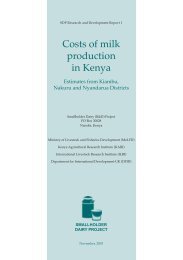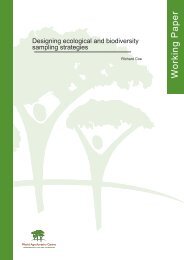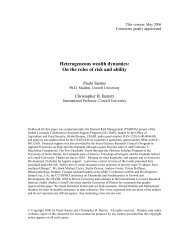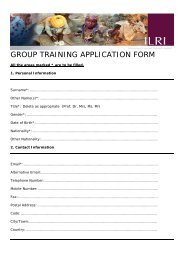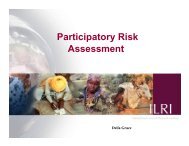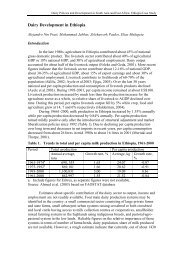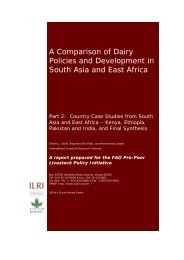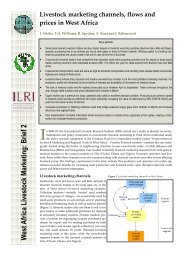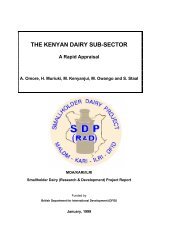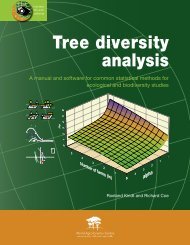Improvement of Livestock Production in Crop-Animal Systems in ...
Improvement of Livestock Production in Crop-Animal Systems in ...
Improvement of Livestock Production in Crop-Animal Systems in ...
Create successful ePaper yourself
Turn your PDF publications into a flip-book with our unique Google optimized e-Paper software.
well <strong>in</strong>tegrated <strong>in</strong>to the farm<strong>in</strong>g systems. In the more sub-tropical and tropical regions <strong>of</strong> Ch<strong>in</strong>a, buffaloesand cattle are used widely to supply draft power for cultivation and haulage and milk. Currently, not enoughis known about the methodologies used for <strong>in</strong>tegration <strong>in</strong> these mixed farm systems, the rationale for us<strong>in</strong>gone or more <strong>of</strong> the chosen species, the role <strong>of</strong> <strong>in</strong>digenous knowledge and, more particularly, the effects <strong>of</strong>their <strong>in</strong>teractions <strong>in</strong> economic and environmental terms. A better understand<strong>in</strong>g <strong>of</strong> these <strong>in</strong>tegrated systemsand potential improvements to them through strategic research will be valuable <strong>in</strong> the development <strong>of</strong> moresusta<strong>in</strong>able production systems, which will have relevance to other countries <strong>in</strong> the region.Feed resourcesThe available feed resources are diverse and <strong>in</strong>clude grasslands (native and sown), crop residues, AIBP andNCFR. Inventories <strong>of</strong> these feeds <strong>in</strong> terms <strong>of</strong> the availability, quality and seasonality <strong>of</strong> production have notbeen undertaken systematically. The use <strong>of</strong> gra<strong>in</strong> to feed pigs and poultry is a major issue, s<strong>in</strong>ce surplusesfrom with<strong>in</strong> Ch<strong>in</strong>a are presently <strong>in</strong>adequate to meet animal requirements, with the result that the country isnow a net importer <strong>of</strong> gra<strong>in</strong>s. Currently, strategies are be<strong>in</strong>g aimed at reduc<strong>in</strong>g imports and the costs <strong>of</strong> animalproduction. For pigs and poultry, an important challenge is to f<strong>in</strong>d locally produced substitutes for gra<strong>in</strong> <strong>in</strong>the diet <strong>of</strong> these species.To address the critical issue <strong>of</strong> feeds, the Institute <strong>of</strong> <strong>Animal</strong> Science <strong>in</strong> CAAS has <strong>in</strong>itiated a majorproject with<strong>in</strong> the N<strong>in</strong>th Development Plan (1996–2000) to <strong>in</strong>vestigate the present status and potential <strong>of</strong>feed resources for herbivore animals <strong>in</strong> cropp<strong>in</strong>g areas <strong>in</strong> Ch<strong>in</strong>a. The work will be undertaken <strong>in</strong> five prov<strong>in</strong>ces<strong>in</strong> central Ch<strong>in</strong>a (Anhui, Hebei, Henan, Shangdong and Shanxi), and six prov<strong>in</strong>ces <strong>in</strong> South Ch<strong>in</strong>a (Fujian,Guangxi, Guangdong, Guizhou, Hunan and Yunnan).Hunan Prov<strong>in</strong>ceHunan Prov<strong>in</strong>ce <strong>in</strong> southern Ch<strong>in</strong>a lies between latitudes 25 and 30° North. The climate is sub-tropicalmonsoonal, with an annual ra<strong>in</strong>fall <strong>of</strong> 1400–1600 mm. The average annual temperature is 16°C and 270 daysare frost-free. The climatic conditions are good for a wide range <strong>of</strong> crops. Soils are generally deficient <strong>in</strong>nitrogen, and 70–80% are deficient <strong>in</strong> phosphorus. Other deficiencies <strong>in</strong>clude potassium, boron and z<strong>in</strong>c. Theprov<strong>in</strong>ce covers an area <strong>of</strong> 211,800 km 2 and has a human population <strong>of</strong> 64 million. There are 15 millionhouseholds farm<strong>in</strong>g 7.3 million ha <strong>of</strong> cropland, <strong>of</strong> which 0.8 million ha are <strong>in</strong> the uplands (non-paddy rice<strong>in</strong> areas with >15% slope). Over 6.0 million ha <strong>of</strong> forest and over 2.0 million ha <strong>of</strong> native grasslands occurma<strong>in</strong>ly <strong>in</strong> the uplands. Average farm size varies but is generally under 1.0 ha.Rice is the most important crop <strong>in</strong> the prov<strong>in</strong>ce cover<strong>in</strong>g about 4.1 million ha. Early-season rice covers2.6 million ha, late-season rice (ma<strong>in</strong>ly hybrids) covers 0.9 million ha, and s<strong>in</strong>gle-season rice (ma<strong>in</strong>lytraditional varieties) covers about 0.6 million ha. More than 70% <strong>of</strong> early- and late-season rice is grown underirrigation. Early season rice is sown at the end <strong>of</strong> March and harvested at the beg<strong>in</strong>n<strong>in</strong>g <strong>of</strong> July. Late-seasonrice is sown <strong>in</strong> early July and harvested <strong>in</strong> mid-August. Hybrid rice development is a special achievement <strong>of</strong>the prov<strong>in</strong>cial academy <strong>of</strong> agricultural sciences. Other crops <strong>of</strong> importance <strong>in</strong>clude wheat, barley, oil–rape,maize, vetch (for green manure) and vegetables. Typical cropp<strong>in</strong>g patterns <strong>in</strong>clude early rice/vetch–late rice;rice/oil–rape; early rice–late rice–wheat; maize–rice; rice–watermelon and chili–rice. In the uplands,soyabean, sweet potato, potato, cotton and maize are also produced. Both organic and <strong>in</strong>organic fertilisersare applied to crops.Mixed farm<strong>in</strong>g systems are extremely important <strong>in</strong> the prov<strong>in</strong>ce, and more than 90% <strong>of</strong> the farmerskeep animals. Pigs are the most important species and the prov<strong>in</strong>ce is the major producer <strong>of</strong> pork <strong>in</strong> Ch<strong>in</strong>a.Poultry (chicken, ducks and geese) are the second most important farm animals followed by cattle and goats.Cattle and buffaloes are kept for draft power, manure, and milk production. Goats are valued for meat,although the production <strong>of</strong> hides from the Black goat (probably orig<strong>in</strong>at<strong>in</strong>g from the Black Bengal breed <strong>of</strong>India), whilst important, is not be<strong>in</strong>g exploited commercially. In the lowland rice-grow<strong>in</strong>g areasnon-rum<strong>in</strong>ants predom<strong>in</strong>ate whilst, <strong>in</strong> the uplands, cattle and goats are more common.In 1996, 90 million pigs, 558 million poultry, 6.8 million cattle and buffaloes, and 8.1 million goatswere produced, <strong>of</strong> which 59, 57, 24 and 44%, respectively, were sold, <strong>in</strong>dicat<strong>in</strong>g a fairly high <strong>of</strong>f-take. Some,41% <strong>of</strong> the value <strong>of</strong> the agricultural output <strong>in</strong> the prov<strong>in</strong>ce came from animals, and 70–80% <strong>of</strong> the value <strong>of</strong>



